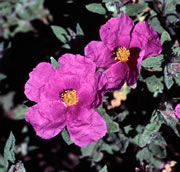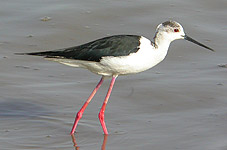 |
Eastern reaches: forests of Pinheiro and the northern salinas
Much of the eastern part of the estuary lies within a private estate (Herdade
de Pinheiro), although the track signposted 'Pinheiro' (west off the N-5) runs for
several kilometres through sparse cork oak and pine forest before reaching the gates.
 Cistus crispus
© Teresa Farino
An understorey of sage-leaved and gum cistuses, Cistus psilosepalus, C. crispus, Halimium
lasianthum ssp. lasianthum and Phillyrea latifolia provides cover for Eurasian badger, western
polecat, Egyptian mongoose and Iberian hare, with sunny glades dotted with palmate anemone,
Linaria spartea, three-leaved snowflake and Scilla monophyllos in spring. Little, long-eared,
tawny and barn owls, hoopoe, lesser spotted woodpecker, woodlark, crested tit, azure-winged
magpie, rock sparrow and cirl bunting can be seen here all year round, joined by short-toed
and booted eagles, bee-eater, wryneck and woodchat shrike in summer and woodcock and firecrest
in winter.
Cistus crispus
© Teresa Farino
An understorey of sage-leaved and gum cistuses, Cistus psilosepalus, C. crispus, Halimium
lasianthum ssp. lasianthum and Phillyrea latifolia provides cover for Eurasian badger, western
polecat, Egyptian mongoose and Iberian hare, with sunny glades dotted with palmate anemone,
Linaria spartea, three-leaved snowflake and Scilla monophyllos in spring. Little, long-eared,
tawny and barn owls, hoopoe, lesser spotted woodpecker, woodlark, crested tit, azure-winged
magpie, rock sparrow and cirl bunting can be seen here all year round, joined by short-toed
and booted eagles, bee-eater, wryneck and woodchat shrike in summer and woodcock and firecrest
in winter.
The northern shores of the estuary are much more humanised, with minor roads south off the
N-10 to the east of Setúbal giving access to the waterside settlements of Mitrena, Praias do
Sado, Gāmbia and Zambujal. At Praias do Sado, the tracks running between the salinas and
 Black-winged Stilt
Black-winged Stilt
Himantopus himantopus
© John Muddeman
fish-ponds are worth exploring at high tide in winter, when you should come across greater
flamingo, black-winged stilt, grey and Kentish plovers and black-tailed godwit, as well as
marsh harrier and bluethroat. A little further on, the tip of the Mitrena peninsula combines
saltmarsh, brackish pools and creeks on one side with Mediterranean pinewoods on the other, and
is a noted haunt of osprey in winter.
The salinas adjacent to the Ribeira de Marateca near Zambujal are also worth a
visit, for close-up views of avocet, black-winged stilt, redshank, little stint, ruff, greenshank
and grey plover during the winter, with common gulls sometimes putting in an appearance.
The surrounding marshy fields support good numbers of little egrets, white storks and marsh
harriers at this time of year. The reedbeds and scrub along the margins of the fields are
patrolled by vociferous groups of waxbills, while the few trees of the area provide suitable
habitat for tree sparrows.
|